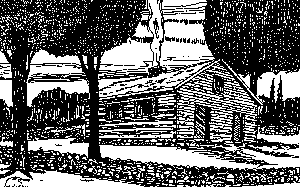Heritage Landmarks: United Brethren Founding Sites Cluster, Frederick and Washington Counties
A Traveler’s Guide to the Most Sacred Places in The United Methodist Church
Originally posted by the General Commission on Archives & History
» View the original article
» Download the PDF of all United Methodist Heritage Landmarks
 The cluster includes the United Brethren founding place at the Peter Kemp house, homes
The cluster includes the United Brethren founding place at the Peter Kemp house, homes
The Geeting Meetinghouse (1774) was succeeded by Mt. Hebron (1845-80) then by Salem at Keedysville. The conference-owned site has hosted annual Whitsuntide meetings since 1770.
George Adam Geeting (1741-1812) served from 1774-1812, was ordained by Otterbein in 1783 and served as Conference secretary from 1800-1812. His attractively restored house was a Civil War Hospital and now is a Washington County historical site.
At the Peter Kemp House on September 25, 1800, the Church of the United Brethren in Christ was organized. In 1950, the Evangelical United Brethren erected a commemorative marker on the lawn.
Bishop Christian Newcomer (1749-1830), preached from 1777, acted as bishop from 1813-30 and consequently extended the church westward. He rests at Beaver Creek cemetery near the Washington County historical site at his former home.
Bishop John Russell (1799-1870), who helped begin United Brethren publishing, also trained preachers at his well-preserved home which was used as a hospital after the Battle of Antietam.
Trinity United Church of Christ, Frederick has a tower erected during Otterbein's 1760s pastorate and Centennial UMC commemorates the United Brethren centennial of 1900.
Points of Interest at this Heritage Landmark: Frederick, Maryland (1745), the city of spires, Barbara Fritchie, the grave of Francis Scott Key, and the Hessian barracks has a long United Methodist history. The Opera House (once also the City Hall) housed the 1901 United Brethren
Keedysville area: The Salem United Methodist Church, at 25 South Main Street, has historical exhibits. At the Mt. Hebron site off Dog Street Road
Beaver Creek area: The Newcomer house on the south side of US 40 west of MD 66 is attractively restored by the new owners. The Brethren Cemetery is one half of a mile west and has a twentieth-century Newcomer stone.
Special events: Pentecost service is held annually at the Mt. Hebron site near Keedysville.
Area attractions: There are many attractions at Frederick, including a county fair and walking tours. The Strawbridge Shrine, where American Methodism began, is twenty miles northeast near New Windsor where Church World Service packs life-saving drugs and clothing for overseas disaster victims. Antietam battlefield is five miles southwest of Keedysville. Heritage Landmarks in Baltimore include: Old Otterbein United Methodist Church, the Lovely Lane meetinghouse
To visit: The exteriors of all the cluster sites may be visited anytime. The interiors of the private houses, except the Kemp house, are not open. To access Trinity Tower apply at the church, on
Location: The cluster sites are within the Washington-Baltimore Conference in Washington and Frederick Counties, Maryland, about forty miles west of Baltimore.
Food and lodging: There are ample facilities are in the Frederick and Hagerstown areas for food and lodging.
Directions: Access from the East or West via I 70 or US 40; from the North via US 15; from the South via US 15 or I 270. Access Keedysville via MD 66 & MD 34 from I 70 or US 40.
For further information, contact: Rev. Al Deal, Salem UM Church, 25 South Main Street, P.O. Box 25, Keedysville, MD 21756-0025; 301-432-4046; or E-mail .
To learn more about United Brethren & United Methodist history in this area:
- Lovely Lane Museum, 2200 St. Paul Street, Baltimore, MD 21218; 410-889-4458.
- Paul E. Holdcraft, History of the Pennsylvania Conference of the Church of the United Brethren in Christ(Fayetteville, PA, 1939).
- Gordon Pratt Baker, ed., Those Incredible Methodists (Baltimore, MD: Commission on Archives and History, 1972).
